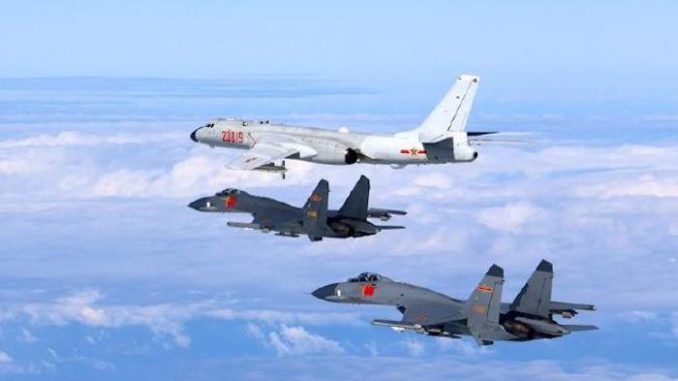
China has launched its largest ever World War 3 drills ‘in areas it has never flown before’ in a clear message to the US to ‘back off.’
Swarms of combat aircraft have crowded the airspace in North Korea, Taiwan, Okinawa and the South China Sea in a deliberate display of China’s military strength to the West.
News.com.au reports: Beijing is being coy about exactly when and where it staged its demonstrations, choosing to reveal it had sent warplanes through “routes and areas it has never flown before” on the same day the US and South Korea launched large scale mock airstrikes involving 230 aircraft.

BYPASS THE CENSORS
Sign up to get unfiltered news delivered straight to your inbox.
You can unsubscribe any time. By subscribing you agree to our Terms of Use
North Korea criticised the show of force, stating US President Donald Trump was “begging for nuclear war”.
Beijing, it appears, is thinking along similar lines. “The timing of this high-profile announcement by the PLA is also a warning to Washington and Seoul not to provoke Pyongyang any further,” Beijing military analyst Li Jie told Chinese reportedly told state media.
Chinese Air Force drills in the Xisha Islands on Nov. 29, 2017, showcasing China's improving combat capability to secure its sovereign security in the #SouthChinaSea pic.twitter.com/pcdMGbcaUO
— People's Daily, China (@PDChina) December 1, 2017
CHINA STEPS FORWARD
Chinese media has broadcast several significant movements of Chinese air force units in recent weeks, including a redistribution of squadrons along coastal regions – including the controversial Woody Island airfield in the Paracel Islands.
These came even as Pyongyang successfully launched its biggest, and longest-ranged, experimental intercontinental ballistic missile yet.
#PLA air force under the Northern Theater Command conduced a combat training above the Jiaodong Penninsula, East China on Nov. 27 pic.twitter.com/WBmI5ROGY6
— People's Daily, China (@PDChina) December 2, 2017
Beijing says its exercise included the use of reconnaissance and AWACS radar control aircraft working in conjunction with strike fighters. It included the rapid redeployment of PLAAF aircraft from deep within China to coastal districts before flying far out to sea.
Mainland spokesperson: Recent exercises of PLA military planes near Taiwan were planned regular training; biggest guarantee to stability of Taiwan Strait is to oppose 'Taiwan independence,' adhere to the 1992 Consensus & take a path of peaceful development for cross-Strait ties pic.twitter.com/6KCTGvr4yC
— People's Daily, China (@PDChina) November 29, 2017
The operations were in and around Beijing’s self-declared air defence identification zone over the East China and Yellow Seas. Arbitrarily announced in 2011, this includes vast tracts of international airspace and waters claimed as sovereign by Japan and South Korea.
In pics: Chinese Air Force launched massive confrontation drills “Red Sword-2017” at the end of this month in NW China pic.twitter.com/57GltY84Oz
— People's Daily, China (@PDChina) November 29, 2017
Emboldened by its rapidly expanding and modernising military, and its success in simply pushing its way into the South China Sea through the construction of illegal artificial fortress islands, People’s Liberation Army Air Force spokesman Shen Jinke declared this kind of training in the East China Sea will become a regular occurrence.
RUSSIA MAKES A MOVE
Two Russian strategic bombers along with two heavy airlifters carrying 81 military and support personnel have made the long flight across East Asia to visit the Indonesian state of Biak, Papua, to Australia’s north.
The Ilyushin-76 airlifters arrived at Frans Kaisiepo Airport on Monday and Tuesday. They were followed by two Tupelov Tu-95 bombers which were refuelled by tanker aircraft while crossing the Pacific Ocean.
Два стратегических ракетоносца Ту-95МС и два самолета Ил-76МД Воздушно-космических сил совершили перелет с аэродрома в Амурской области на аэродром Биак Республики Индонезия в рамках международного визита https://t.co/bjZGtzEwcJ pic.twitter.com/dld9pmGj4K
— Минобороны России (@mod_russia) December 5, 2017
Russia’s Ministry of Defence says the force is there for “navigation exercises”.
“They will only stay in Biak. They won’t go anywhere else,” Manuhua Biak Airport spokesperson First Lieutenant Putukade Wempy told The Jakarta Post yesterday.
The Russians are expected to stay until Saturday.
“The planes fly directly from Russia for 12 hours, and this will be the first time they have flown near the equator,” said Manuhua Biak Air commander Colonel Fajar Adriyanto. “They usually fly in temperatures of minus 37 degrees, now they will fly in plus 37 degrees. So it will really be a 100 per cent change.”
RAAF Base Amberley is hosting two @usairforce B-1B Lancers as part of #ExLightningFocus. Nicknamed “The Bone,” the B-1B Lancer ✈️ is a long-range, multi-mission, supersonic conventional bomber, which has served the United States Air Force since 1985. #AusAirForce #USAF 🇺🇸 pic.twitter.com/0WOiCS88rb
— Royal Australian Air Force (@AusAirForce) November 30, 2017
Colonel Fajar said the Russian warplanes were not armed as their exercises would only involve long-distance flying over the Pacific.
“The exercises have no other purpose. Their arrival will also promote Biak as a tourist destination,” Colonel Fajar said.
The move appeared time to cooincide with the recent deployment ot Australia of two US B-1B Lancer strategic bombers.
HIGH-PROFILE STEALTH
China’s moves may be an attempt to up-stage large scale manoeuvres by the United States and Korea, involving an unprecedented 24 stealth F-22 Raptor and F-35 Lightning fighters earlier this week.
Along with 220 conventional combat aircraft, the combined forces simulated their ability to ‘ surgically strike’ mobile launchers, command posts and military facilities as part of operation Vigilant Ace. It coincided with manoeuvres involving 12,000 sailors, marines and troops and involved some 700 mock targets designed to emulate key North Korean infrastructure.
Combined U.S.-ROK forces send 230 aircraft – including 5th-generation stealth fighters – to Exercise #VigilantAce, ensuring alliance #airpower is ready to #FightTonight if necessary to defend Korea https://t.co/ER3BxaPCOi pic.twitter.com/A8X0pFTFHv
— U.S. Indo-Pacific Command (@INDOPACOM) December 5, 2017
The wargames were a clear signal to Kim Jong-un’s North Korea that the West is willing and able to strike its controversial nuclear facilities.
It was a message not lost on Pyonyang.
The US was “staging an ultra-precision strike drill with high intensity just like in a real war focused on ‘removing’ the DPRK’s state leadership and core facilities by massively introducing the ultramodern stealth fighters,” North Korea’s state media said.


